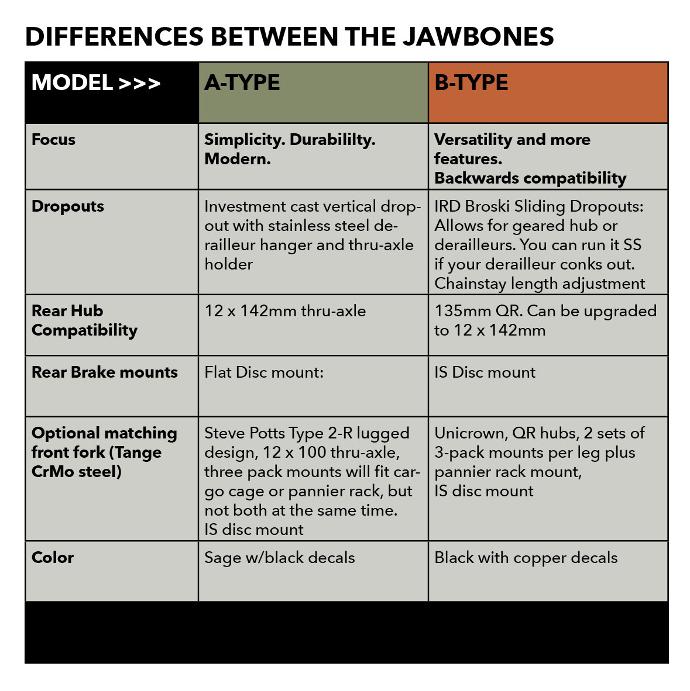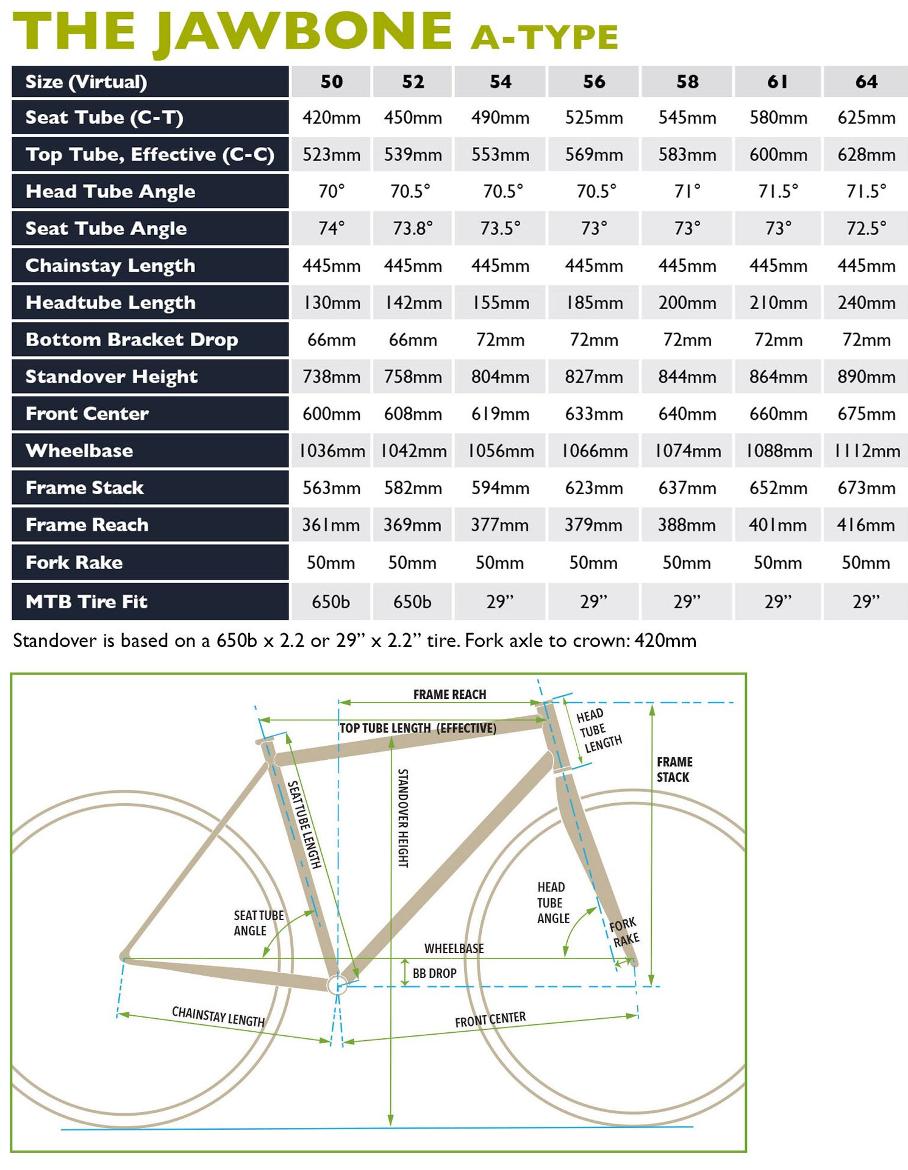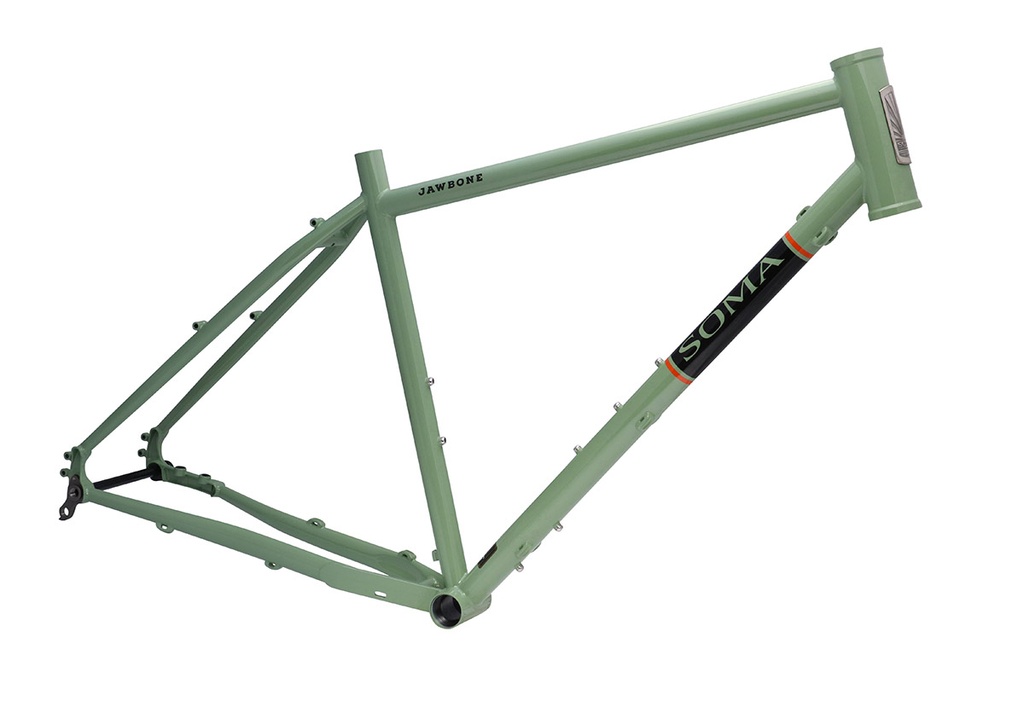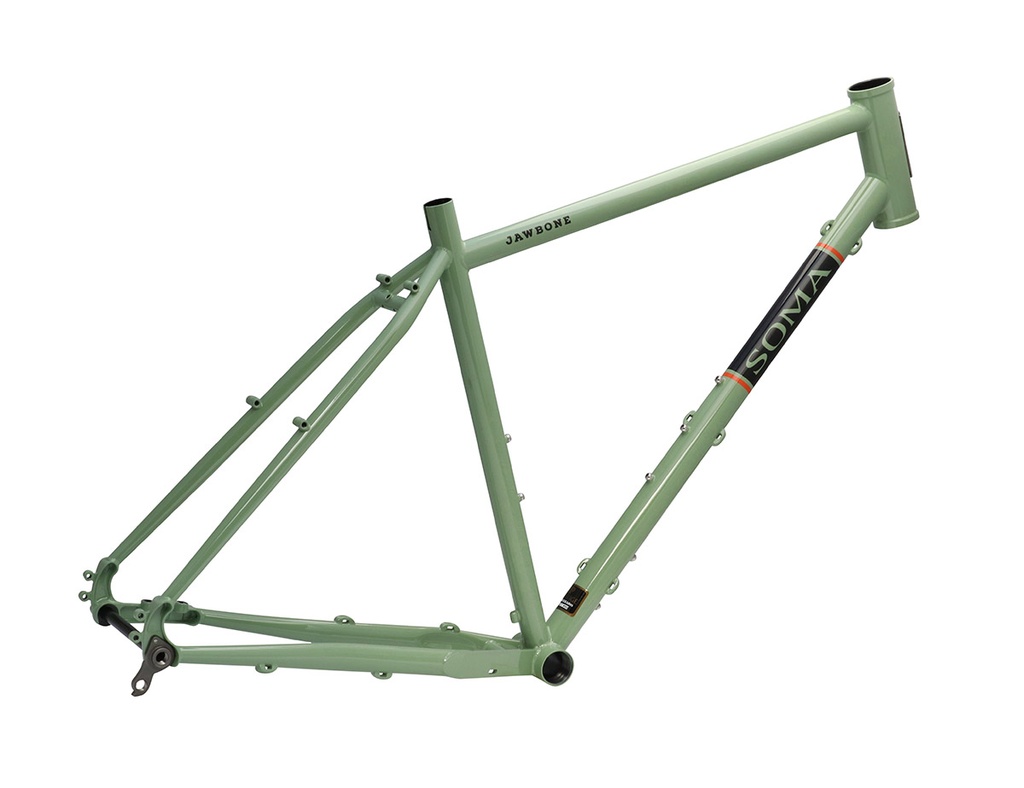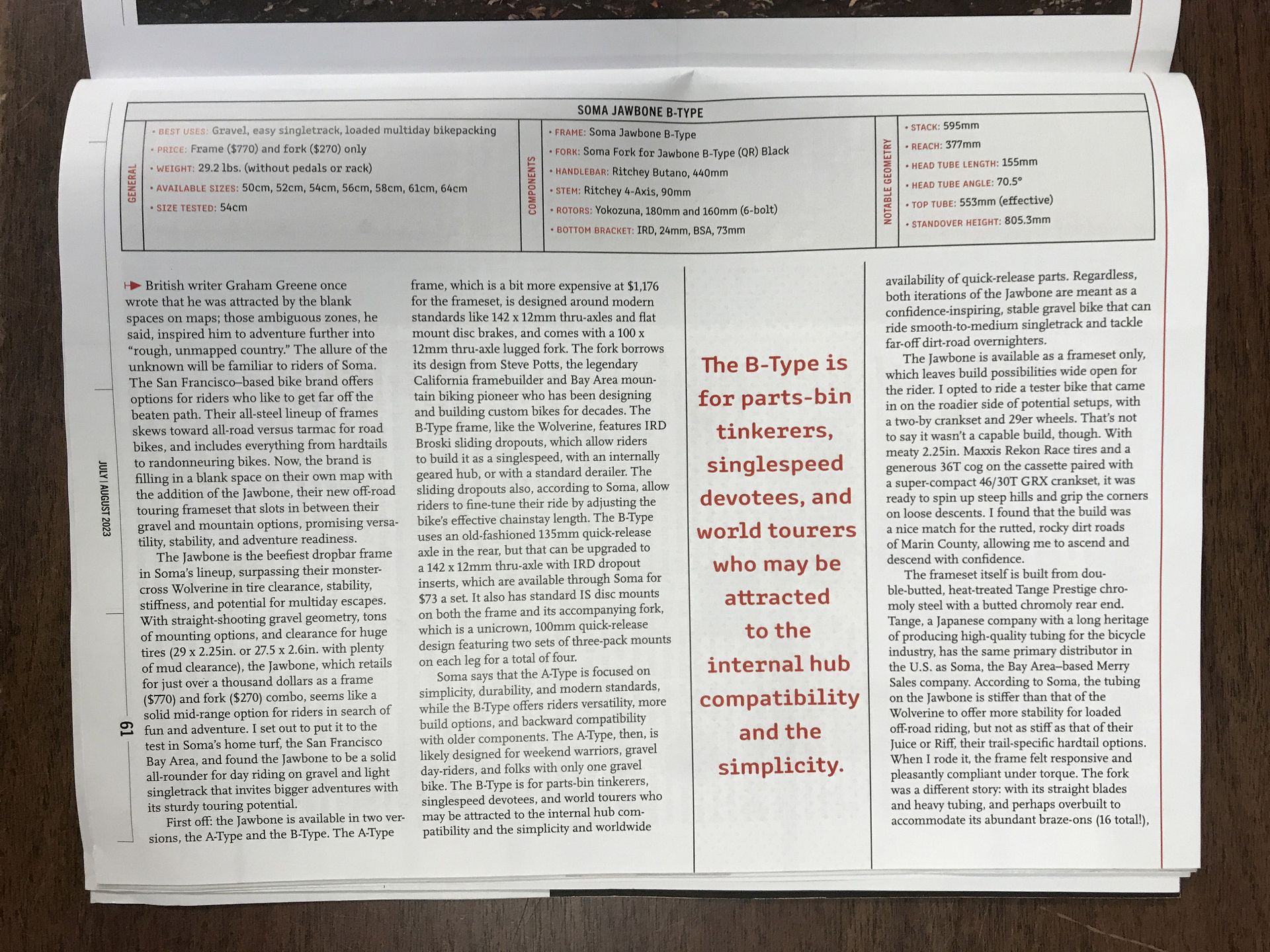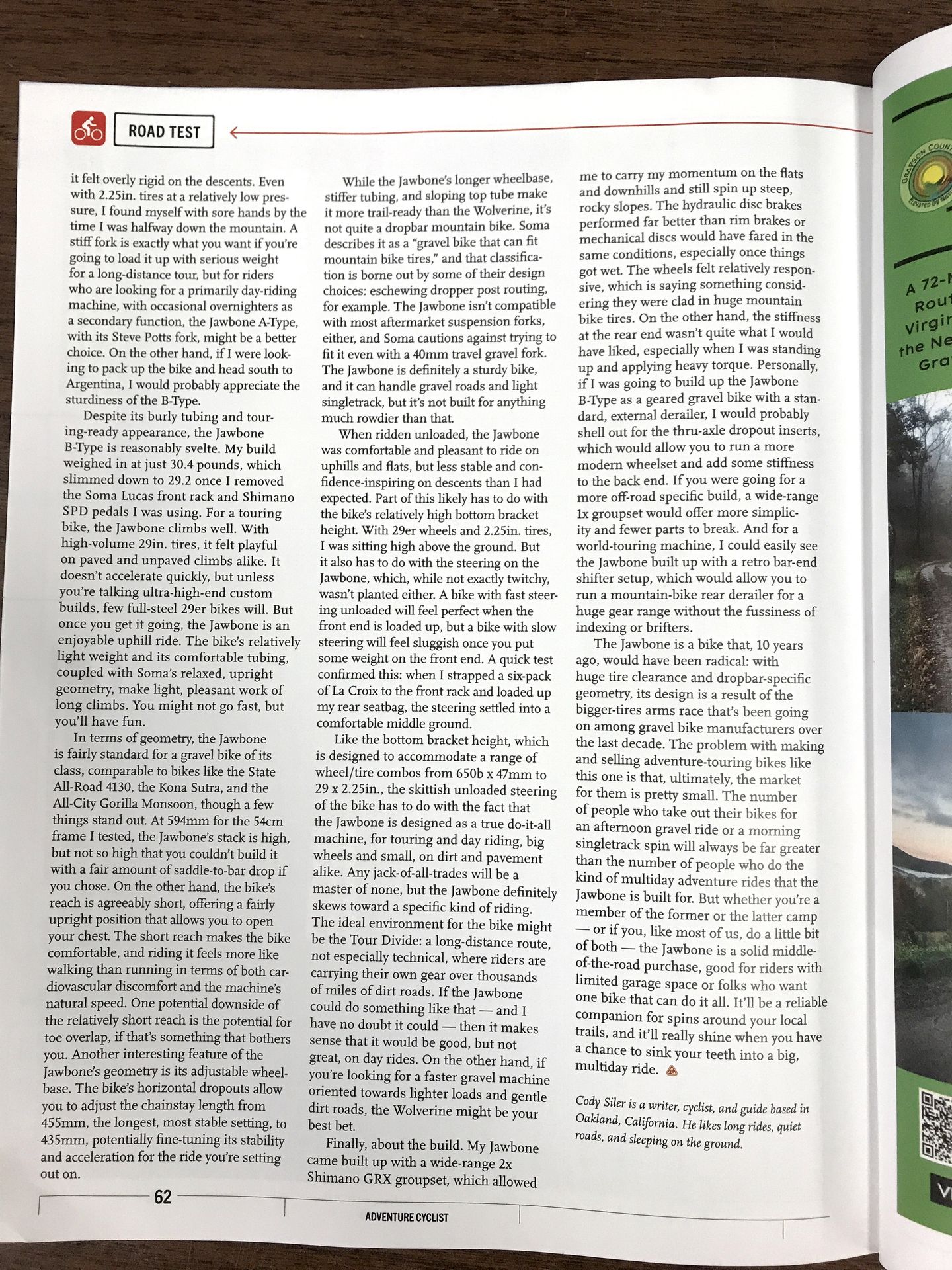Jawbone A-Type Full Specs
FRAME SPECS
- Headset for optional 1-1/8" matching fork: SHIS: ZS44/28.6 | ZS44/30). If running a tapered steerer fork, get an EC44 lower cup
- Front derailleur: 28.6mm ID, bottom pull
- Seatpost: 27.2mm
- Seat collar: 29.8 or 30.0mm (not included)
- Rear thru-axle spacing: 12x142mm, Shimano 1.5 TP
- Replaceable dropout hanger: Long Shen LR-27 3A or 3A1 - Brakes: Disc (Flat disc mount 140mm rotor; we recommend sizing up to 160mm)
- Bottom bracket shell: 73mm wide, English threads
- Max.Tire Clearance: 29 x 2.25 and 27.5(650b) x 2.5"
On size 50cm and 52cm, we recommend not using tires more than 27.5 x 2.2 to reduce toe overlap issues
- Chainring clearance: Mountain 1x and 2x, 2x 48/31
- Guides for full length cable housing
- Water bottle bosses: On seat tube and under down tube
- Cargo cage Bosses (Three-pack mounts): One set on down tube.
- Rack and Fender mounts: Two at dropout
- Max. weight with rider and load: 270 lbs.
- Acceptable fork lengths: 417-425mm
- Acceptable fork rake: 44mm - 50mm
STEVE POTTS TYPE II-R MTB FORK SPECS:
- Axle to crown: 420mm
- Rake: 50mm
- Steerer length: 350mm
- Two sets of three-pack mounts. These can also be used for a pannier rack, but not at the same time as with a cargo cage.
- Rack and Fender mounts: Two at fork end
- Brake mounts: IS (will fit post mount brakes with an adapter. will not fit flat mount brakes or A.S. Solutions adapter); max rotor: 180mm
Can I run a carbon fork or another brand of steel fork on the Jawbone?
You can run a carbon fork, but note the fork you choose will probably not be as durable for bikepacking or fit as wide a tire as the steel forks we offer as options. Note also our largest frame requires a steerer at least 350mm and not many carbon forks have that.
The Jawbone frame is designed around a 420-425mm fork with a Zero Stack (ZS44) headset. Most carbon forks have a tapered steerer and require a EC44mm External Lower Cup headset. An external cup adds stack, so it need to be added to the over all fork length. (We use a 12mm lower cup in the illustration below)
1) IRD MCX Max - 406mm + 12mm = 418mm(OK)
2) Whisky No. 9 MCX - 415mm + 12mm = 427mm(OK)
3) Lithic Hilli - 420mm + 12mm = 432mm (Not recommended)
The Lithic Hilli is a nice fork, but could noticeably change how the Jawbone steers, so we hesitate to give it a recommendation. Forks 400mm and shorter are also not recommended.
As for steel, the only forks we know with an acceptable axle to crown length is the Surly Bridge Club fork, but it may not have the 29" tire clearance of our fork options.
Can I run a flat bar on the Jawbone?
Yes, but please keep in mind that the Jawbone is designed specifically as a drop bar mountain bike. Switching to a flat bar shortens your cockpit length a lot compared to how a traditional flat bar mountain bike would be designed.
Can I put a suspension fork on the Jawbone?
The Jawbone is designed around a 420mm rigid fork and is not compatible with 27.5"/29" mountain suspension forks. It could possibly fit some 40mm travel gravel forks, but those forks may be long enough to effect front end handling, are rather pricey for the amount of travel and may not have as much tire clearance as our matching rigid fork.
How rowdy can I get on the Jawbone? Can I ride like a modern trail bike?
In terms of durability and capability, we would describe the Jawbone as gravel bike that fits mountain bike tires. It is stiffer and has a longer wheelbase than the Wolverine frame to carry loads more confidently. It has more slope to the top tube, so it feels more like a mountain bike. But the frame though stiffer is not as ruggedly built as our hardtail frames. It is not suspension ready, so you probably can't ride it as hard a modern "trail" or "down-country" bike anyway. Ideal element: Gravel. Singletrack. Double track. Rolling terrain. Not the best bike to bomb down black diamonds and super rocky terrain. Pick smart lines on rugged blue and green trails and you should be alright.
Does the Jawbone have a kickstand plate?
No it does not. And it will not fit a kickstand inbetween the chainstays either. That is probably the only reason we don't call the Jawbone a traditional loaded touring bike. Road touring bikes almost always have kickstands. The Jawbone is a bikepacking bike. Generally kickstands don't work that well on dirt and uneven terrain.
